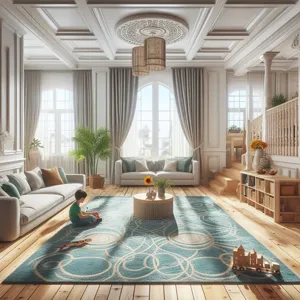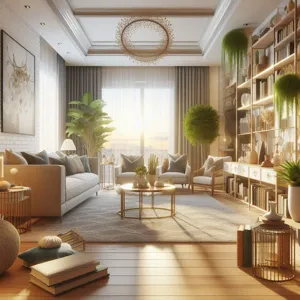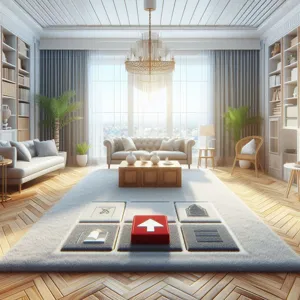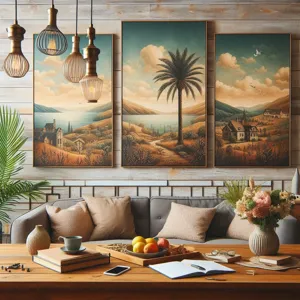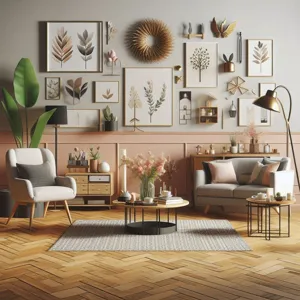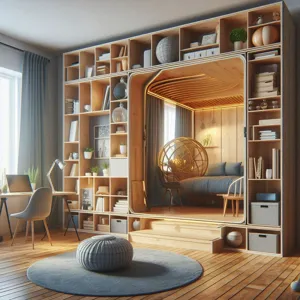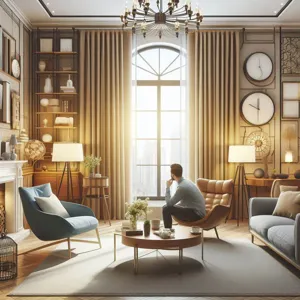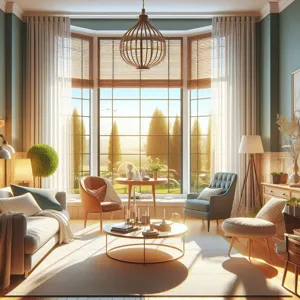In an increasingly noisy world, the importance of a serene and acoustically balanced home cannot be overstated.
Whether you’re trying to create the perfect environment for relaxation, focus, or entertainment, the sound quality in your living space plays a pivotal role in your overall experience. From the gentle hum of background music to the crisp clarity of your favorite movie dialogue, the acoustics of your home can significantly shape how you feel and interact within your environment. In this blog post, we will explore top tips for transforming your space into a sanctuary of sound, offering practical insights on everything from the strategic placement of furniture to the selection of sound-absorbing materials. Join us as we delve into the art and science of enhancing your home’s acoustics, ensuring that every sound you hear contributes to a harmonious and enjoyable living experience.
1. Understanding Acoustics: What You Need to Know

Understanding acoustics is the foundation for transforming your space into a harmonious haven. Acoustics refers to the science of sound—how it travels, how it interacts with different surfaces, and how we perceive it within a given environment. The way sound behaves in a room is influenced by various factors, including the size and shape of the space, the materials used in construction, and the placement of furniture and decor.
To grasp the essentials of acoustics, it’s important to recognize the difference between sound absorption, reflection, and diffusion. Sound absorption is the process of materials soaking up sound waves, reducing echo and reverberation. Soft furnishings like carpets, curtains, and upholstered furniture play a significant role in this. On the other hand, sound reflection occurs when sound waves bounce off hard surfaces, such as walls, ceilings, and floors, which can lead to an echoing effect that distorts sound clarity.
Diffusion, meanwhile, describes the scattering of sound waves in various directions, which can help create a more balanced auditory experience. This can be achieved through the strategic placement of objects like bookcases, plants, or specialized acoustic panels that break up sound waves and minimize harsh reflections.
When designing your space, consider how sound travels through it. Are there areas that are overly loud or disturbingly quiet? Recognizing these variations is the first step in enhancing your home’s acoustics. By understanding the basic principles of acoustics, you can make informed choices about materials and layouts that contribute to a pleasant auditory environment, ultimately transforming your space into a peaceful retreat where sound feels just right.
2. The Importance of Good Acoustics in Your Home
Good acoustics in your home play a pivotal role in shaping not only the overall ambiance but also the functionality of your living space. Imagine a warm evening, where laughter fills the air during a gathering with friends, or a quiet morning spent reading your favorite book without the distraction of echoes or muffled sounds. These experiences hinge on how sound travels and resonates within your home.
When acoustics are optimized, you can enjoy clearer conversations, reduced noise pollution from outside, and a more serene atmosphere overall. Poor acoustics, on the other hand, can lead to frustrating echoes, unwanted reverberation, and a cacophony of sounds that disrupt the peaceful environment you strive to create. This is particularly crucial in open-concept homes, where sound can bounce off hard surfaces, creating a disjointed auditory experience.
Moreover, good acoustics contribute to the functionality of spaces such as home theaters, music rooms, or even your home office. Imagine watching your favorite film with crystal-clear sound, or playing an instrument with the richness and depth of sound that enhances your performance. Effective acoustic design can transform these experiences, making them more enjoyable and immersive.
Additionally, good acoustics can even improve your mental well-being. Studies have shown that excessive noise can lead to stress and anxiety, while a well-balanced sound environment promotes relaxation and focus. By investing in the right acoustic solutions, such as soundproofing materials, soft furnishings, and strategic furniture placement, you can create a harmonious home that fosters comfort and tranquility.
In essence, prioritizing good acoustics is not just about eliminating noise; it’s about enriching your daily life and creating a sanctuary where every sound contributes to a balanced, enjoyable living experience.
3. Identifying Common Acoustic Problems in Different Rooms

To effectively enhance your home’s acoustics, it’s crucial to first identify the common acoustic problems that can arise in different rooms. Each space in your home has unique characteristics that influence sound quality, and being aware of these issues can guide you in implementing the right solutions.
**Living Room:** Often the heart of the home, the living room is typically designed for comfort and conversation. However, its open layout and hard surfaces can create an echo, making it difficult to hear conversations clearly. Excessive reverberation can detract from movie nights or gatherings with friends. Look for sound-absorbing materials like plush sofas, area rugs, and heavy curtains to help manage sound reflections.
**Bedroom:** A sanctuary for rest, the bedroom should be a peaceful retreat. Unfortunately, noise from outside traffic or even the sounds of family members can disrupt your tranquility. If your bedroom feels too noisy, consider adding soundproofing curtains or weather stripping to windows and doors. Additionally, incorporating soft furnishings, such as thick bedding and upholstered headboards, can dampen sound and create a more serene atmosphere.
**Home Office:** As remote work becomes increasingly common, the home office must support focus and productivity. Acoustic issues here often stem from the transmission of noise from other parts of the house or outside distractions. To combat this, consider using acoustic panels on the walls or a soundproof door. Adding bookshelves filled with books can also act as natural sound barriers, absorbing noise and promoting a quieter environment.
**Kitchen:** While not typically associated with acoustic problems, the kitchen can actually be quite noisy, especially if it is open to the living area. The clattering of dishes and appliances can create a cacophony. To mitigate this, use soft-close cabinets and drawers, and try adding foam mats where you stand for long periods. These small adjustments can significantly reduce the overall sound level and create a more pleasant cooking experience.
**Bathroom:** Lastly, bathrooms often have hard surfaces that create echoes, making them feel more like a noisy chamber than a relaxing spa. To address this, consider adding soft towels, bath mats, and decorative items that can absorb sound. Additionally, installing a quiet exhaust fan can help manage not only moisture but also unwanted noise.
By identifying these common acoustic problems in each room, you can take targeted steps to create a harmonious environment that enhances both comfort and functionality in your home.
4. Choosing the Right Materials for Acoustic Treatment
When it comes to enhancing your home’s acoustics, the materials you choose for acoustic treatment can make all the difference. Selecting the right materials is not just about aesthetics; it’s about creating an environment that optimally absorbs sound, reduces echoes, and enhances overall sound quality. Here are some key materials to consider:
**Acoustic Panels:** These are perhaps the most common choice for improving sound quality in a room. Made from dense foam or fiberglass, acoustic panels are designed to absorb sound waves, thus minimizing reflections and echoes. Available in various colors and designs, they can be both functional and decorative, allowing you to seamlessly blend them into your decor.
**Bass Traps:** If you’re dealing with low-frequency sounds, such as the rumble of bass-heavy music or deep voices, bass traps are essential. These specialized panels are typically placed in the corners of a room where low frequencies tend to accumulate. They help to smooth out the sound and prevent a muddy audio experience.
**Soundproofing Curtains:** For those who may not want to commit to permanent installations, soundproofing curtains offer a flexible solution. These heavy, dense fabrics can significantly reduce sound transmission from outside while also absorbing internal echoes. Choose curtains with a high Noise Reduction Coefficient (NRC) for the best results, and consider their color and texture to complement your room’s aesthetic.
**Rugs and Carpets:** Don’t underestimate the power of soft furnishings. Thick rugs and carpets can absorb sound and reduce noise levels in a room, especially in spaces with hard flooring. Layering rugs can also add a touch of warmth and style while enhancing acoustic properties.
**Bookshelves and Furniture:** Strategically placing bookshelves and upholstered furniture can further improve a room’s acoustics. Bookshelves filled with books act as natural sound absorbers, while soft furniture can help break up sound waves, reducing echo. Consider arranging furniture to create cozy nooks that encourage conversation without excessive noise reverberation.
By thoughtfully selecting materials that suit your space and needs, you can transform your home into an acoustically pleasant environment. Not only will your space feel more comfortable, but it will also enhance your listening experience, whether you’re enjoying music, watching movies, or hosting engaging conversations with family and friends.
5. Strategic Placement of Furniture to Improve Sound
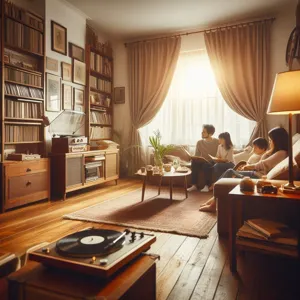
When it comes to enhancing your home’s acoustics, the strategic placement of furniture can make a world of difference. Think of your space as a symphony; each piece of furniture plays a vital role in how sound waves interact and resonate within the room. By thoughtfully arranging your furniture, you can create an environment that not only looks aesthetically pleasing but also optimizes sound quality.
Start with larger pieces, such as sofas and bookshelves, and position them against walls to help absorb sound. These items can act as barriers that reduce echo and dampen noise, providing a more intimate atmosphere. A plush sofa, for instance, can help absorb high frequencies, while dense bookshelves filled with books can neutralize sound waves, preventing them from bouncing around the room.
Next, consider the use of rugs and curtains. A soft area rug can significantly reduce sound reflections in a space, especially if you have hard flooring. The texture of the rug helps to absorb sound waves, creating a cozier, quieter environment. Similarly, heavy curtains can help block external noise and improve acoustics by dampening sound reflections from windows.
Don’t forget about creating “sound zones” in larger rooms. By strategically placing furniture to form distinct areas, you can create pockets of sound that work together harmoniously. For example, an L-shaped sectional can define a conversational area, while a small side table and chairs can create a quiet nook for reading or relaxing.
Finally, keep in mind that the shape and size of your furniture matter. Avoid sharp edges and opt for rounded pieces that help diffuse sound. By considering both the type and placement of your furniture, you’ll be well on your way to transforming your space into an acoustically-friendly oasis. With a few thoughtful adjustments, you can create a home that not only looks good but sounds good too!
6. Layering Textiles: Rugs, Curtains, and Cushions
When it comes to transforming the acoustics of your home, layering textiles is one of the most effective and stylish methods to absorb sound and reduce echoes. Soft furnishings have a remarkable ability to dampen noise, creating a more serene and inviting atmosphere. Start with rugs, as they not only add warmth and comfort underfoot but also act as a sound barrier, especially in larger, hard-surface areas. Opt for thick, plush rugs that can trap sound waves, minimizing the clatter of footsteps and the reverberation of voices.
Next, consider your windows—curtains are a game-changer in enhancing acoustics. Heavy drapes made from dense fabric can significantly reduce outside noise and prevent sound from bouncing around the room. For added effectiveness, layer sheer curtains underneath for a stylish touch that still allows natural light to filter through while softening harsh sounds.
Cushions and throw pillows are the final touch in your textile layer strategy. Scatter them generously across sofas and chairs; they not only provide comfort but also absorb sound, further reducing echoes. Mix and match different textures and patterns to create a cozy aesthetic that complements your décor while serving a functional purpose.
By thoughtfully incorporating rugs, curtains, and cushions into your space, you’ll not only enhance your home’s acoustics but also create a chic, inviting environment that feels harmonious and comfortable. This simple yet impactful approach allows you to enjoy a quieter, more relaxing home without sacrificing style.
7. Utilizing Wall Treatments: Panels, Paints, and Wallpaper

When it comes to enhancing your home’s acoustics, wall treatments play a pivotal role in absorbing sound and reducing unwanted noise. With a variety of options available, you can transform not just the auditory environment of your space, but also its aesthetic appeal.
Acoustic panels are a popular choice among homeowners looking to improve sound quality. Available in a range of materials, colors, and designs, these panels can be strategically placed on walls or ceilings to target specific sound issues, such as echoes or reverberation. Not only do they help in sound absorption, but they also serve as a stylish design element that can bring a modern flair to your home.
If you’re looking for a more seamless solution, consider acoustic paint. This specialized paint is formulated with sound-absorbing properties, allowing you to maintain the look of your walls while enhancing their acoustic performance. It can be applied to any surface, making it an excellent choice for those who want to keep their decor intact while still addressing sound issues.
For a more textured approach, wallpaper can also contribute to improved acoustics. Thicker wallpapers, especially those with fabric or textured finishes, can help dampen sound and reduce noise levels. Plus, with an endless variety of patterns and colors available, wallpaper can add a unique touch to your decor while serving a functional purpose.
By utilizing these wall treatments, you can create a more serene and comfortable environment in your home. Whether you’re looking to reduce noise in a busy family room, enhance sound quality in a home theater, or simply create a more peaceful atmosphere, the right wall treatments can make all the difference. Transform your space into a sanctuary of sound with these effective and stylish solutions.
8. Soundproofing vs. Acoustic Treatment: What’s the Difference?
When it comes to enhancing your home’s acoustics, understanding the distinction between soundproofing and acoustic treatment is crucial for achieving the desired results. While these terms are often used interchangeably, they serve different purposes and address different acoustic challenges in a space.
**Soundproofing** is all about keeping sound from entering or leaving a room. It involves creating a barrier that minimizes the transmission of sound waves, making it ideal for spaces where noise pollution is a concern—think of busy streets or lively neighbors. Techniques for soundproofing might include adding mass to walls with heavy materials, sealing gaps around windows and doors, or installing soundproof drywall. The goal is to create a sanctuary where external noises are kept at bay, allowing you to enjoy your space in peace.
On the other hand, **acoustic treatment** focuses on improving the sound quality within a room. This involves managing how sound behaves inside the space, which can often lead to echo or muddiness in audio. Acoustic treatment utilizes materials like foam panels, bass traps, and diffusers to absorb excess sound and improve clarity. This is particularly beneficial in home theaters, recording studios, or any area where clear audio is essential. By strategically placing these treatments, you can create a balanced sound environment that enhances your listening experience.
In summary, while soundproofing aims to block sound from entering or leaving a space, acoustic treatment works to refine the sound within it. Understanding this difference will allow you to make informed decisions on how best to enhance your home’s acoustics, depending on whether you want to keep noise out or improve the sound quality of what’s inside. Investing in the right approach can not only transform your space but also elevate your enjoyment of it, whether you’re hosting a gathering, watching a movie, or simply seeking tranquility.
9. Incorporating Plants for Natural Sound Absorption
Incorporating plants into your home not only enhances its aesthetic appeal but also serves as a powerful tool for improving acoustics. Plants are nature’s sound absorbers, effectively dampening noise levels and creating a more tranquil environment. Their leaves, stems, and even the soil they inhabit can help mitigate sound waves, making your space feel calmer and more inviting.
When selecting plants for acoustic enhancement, consider those with larger leaves and denser foliage. Species like the rubber plant, monstera, or peace lily are not only visually striking but also excellent at absorbing sound. Placing these plants strategically around your home—such as in corners, near windows, or in high-traffic areas—can significantly reduce echoes and soften the harshness of ambient noise.
Moreover, incorporating a variety of plants at different heights creates a more dynamic sound environment. Tall plants can act as natural barriers, breaking up sound waves, while smaller plants on shelves or tables add layers of texture and sound absorption.
Beyond their acoustic benefits, plants also contribute to improved air quality and a sense of well-being, which is essential for any living space. They bring life into your home, create a soothing atmosphere, and enhance your overall quality of life. So, as you embark on your journey to transform your space, don’t underestimate the power of greenery to create a more peaceful and acoustically balanced home.
10. Tips for Improving Acoustics in Open Concept Spaces
Open concept spaces are beloved for their airy feel and the seamless flow they provide between rooms, but they can pose unique challenges when it comes to acoustics. With fewer walls to absorb sound, noise can bounce around, creating echoes and making it difficult to carry on conversations or enjoy your favorite music without distraction. Fortunately, there are several effective strategies to enhance acoustics in these expansive areas.
**1. Incorporate Soft Furnishings**: Soft textiles are your best friends in an open concept layout. Consider adding plush sofas, upholstered chairs, and thick area rugs to help absorb sound. Opt for heavier curtains or drapes to line your windows, which can significantly reduce reverberation when closed.
**2. Add Acoustic Panels**: Decorative acoustic panels are a stylish and functional solution. Available in various colors, shapes, and designs, these panels can be strategically placed on walls or ceilings to dampen sound while adding visual interest to your space. They can blend seamlessly into your decor, ensuring that functionality doesn’t compromise aesthetics.
**3. Use Bookshelves and Plants**: Tall bookshelves filled with books can act as natural sound barriers, breaking up sound waves as they travel through the space. Similarly, adding plants not only enhances the beauty of your home but also contributes to sound absorption. Consider using larger potted plants or even hanging greenery to maximize their impact.
**4. Create Defined Zones**: While open concept living encourages fluidity, visually defining areas can help minimize noise transfer. Use rugs to delineate spaces, or arrange furniture in a way that creates distinct sections for different activities—such as a reading nook or a dining area. This not only enhances the flow but also helps contain conversations and sounds within their respective zones.
**5. Consider Ceiling Treatment**: If you’re open to more extensive renovations, consider installing a drop ceiling with acoustic tiles. This can significantly improve sound quality by absorbing sound waves before they bounce off hard surfaces. If a full ceiling overhaul isn’t in the cards, decorative ceiling beams can also help break up sound paths.
By thoughtfully incorporating these tips into your open concept space, you can create a more enjoyable and acoustically pleasant environment. Whether you’re hosting a lively gathering or simply enjoying a quiet evening at home, these enhancements will help you transform your space into a harmonious retreat that balances style and sound.
11. DIY Acoustic Solutions: Budget-Friendly Ideas
When it comes to enhancing your home’s acoustics, you don’t have to break the bank to create a more pleasant auditory environment. There are numerous DIY acoustic solutions that are both effective and budget-friendly, allowing you to transform your space without emptying your wallet.
**1. Soft Furnishings:** One of the simplest ways to improve sound quality in any room is by incorporating soft furnishings. Think plush rugs, thick curtains, and upholstered furniture. These elements help absorb sound waves, reducing echo and making your space feel cozier. If you’re looking to add a splash of color, consider vibrant textiles that not only serve a practical purpose but also elevate your room’s decor.
**2. Wall Hangings and Art:** Use wall art as a dual-purpose solution. Fabric wall hangings, tapestries, or even acoustic panels creatively disguised as art can help mitigate sound reflection. You can easily create your own acoustic panels by covering lightweight wooden frames with foam or thick fabric. Arrange them artistically on your walls to create a visually appealing soundproofing solution.
**3. Bookcases and Shelving Units:** Strategically placing bookcases or shelving units along walls can also help with sound absorption. Fill them with books, plants, or decorative items to break up sound waves and create a more balanced acoustic environment. For added effect, consider using open shelving, which allows for varied textures and materials, further enhancing sound dampening.
**4. DIY Soundproofing Panels:** If you’re willing to put in a bit of effort, you can create your own soundproofing panels using inexpensive materials such as foam insulation boards or even old mattresses. Cut them to size and cover them with fabric to match your decor. Mount them on walls or ceilings where sound tends to bounce the most, such as corners or near windows.
**5. Plants as Natural Sound Barriers:** Incorporating greenery into your space not only adds life but also helps with acoustics. Tall plants, such as fiddle leaf figs or bamboo, can act as natural sound barriers. The leaves and soil absorb sound, making your home feel quieter and more serene.
**6. DIY Window Inserts:** If outside noise is a concern, consider creating your own window inserts. Use acrylic sheets cut to size and place them inside your existing window frames. This additional layer can significantly reduce noise pollution while being a cost-effective solution compared to full window replacements.
By utilizing these budget-friendly DIY acoustic solutions, you can create a more serene environment that enhances your home’s comfort and livability. With a little creativity and effort, you’ll be well on your way to transforming your space into a peaceful oasis where sound is beautifully balanced.
12. Hiring Professionals: When to Seek Expert Help
While DIY methods can be effective for many acoustic improvements, there comes a point when the intricacies of sound management require a level of expertise that only professionals can provide. If you find yourself grappling with persistent noise issues, or if your sound treatments aren’t yielding the desired results, it may be time to consider bringing in an acoustic consultant or sound engineer.
Professionals in this field possess a wealth of knowledge about sound behavior and acoustics, often backed by years of experience and specialized training. They can conduct thorough assessments of your space, using advanced tools to analyze sound waves, reverberation times, and frequency responses. This objective data allows them to pinpoint problem areas—like echo-prone corners or overly reflective surfaces—that you might overlook.
Additionally, hiring an expert can save you time and money in the long run. While you may be tempted to experiment with various materials and layouts, a professional can streamline the process, recommending specific solutions tailored to your unique environment. Whether it’s installing high-quality acoustic panels, designing custom bass traps, or optimizing the layout of your furniture for better sound distribution, their insights can lead to a significant transformation in your space’s acoustics.
If your home serves multiple purposes—a lively family gathering space, a quiet retreat for reading, or a dedicated music room—the expertise of a professional can help you achieve a harmonious balance that suits all your needs. Remember, enhancing your home’s acoustics is an investment in comfort and quality of life. By recognizing when to seek expert assistance, you can ensure that your efforts lead to an acoustically beautiful and functional space.
13. Maintaining Your Acoustic Enhancements
Maintaining your acoustic enhancements is crucial to ensuring your sound environment remains optimal over time. Just as you wouldn’t let dust settle on your favorite artwork, it’s important to care for the elements that contribute to your home’s acoustics. Regular maintenance not only prolongs the life of your acoustic features but also protects the quality of sound within your space.
Start by routinely inspecting your acoustic panels, diffusers, and bass traps for signs of wear and tear. Dust and grime can accumulate over time, dulling the effectiveness of your soundproofing materials. A simple wipe down with a soft cloth can do wonders, keeping your panels looking fresh and functioning optimally. For fabric-covered surfaces, consider using a vacuum with an upholstery attachment to gently lift away dirt without damaging the material.
If you’ve invested in acoustic treatment like heavy drapes or carpets, check to ensure they haven’t become too worn or faded. Over time, these materials may lose their sound-absorbing properties, necessitating a replacement or a thorough cleaning. For drapes, a wash or professional clean can rejuvenate their appearance and function, while carpets may benefit from regular shampooing or deep cleaning to refresh their acoustical benefits.
Additionally, pay attention to the placement of your acoustic elements. Changes in your furniture arrangement or the addition of new decor can alter the acoustics of a room, potentially diminishing the impact of your enhancements. Regularly reassess your setup, and don’t hesitate to experiment with repositioning elements to find the perfect balance for sound quality.
Lastly, consider the environment in which your acoustic enhancements reside. High humidity or temperature fluctuations can affect materials like wood or fabric, so maintaining a stable indoor climate can help preserve the integrity of your soundproofing solutions. Investing in a hygrometer can help you monitor humidity levels, ensuring they remain in the ideal range to protect your acoustic enhancements.
By prioritizing the maintenance of your acoustic enhancements, you ensure that your home continues to be a sanctuary for sound, providing an enriching auditory experience that you and your guests can enjoy for years to come.
14. The Impact of Acoustics on Mental Well-Being
The impact of acoustics on mental well-being is often an overlooked aspect of home design, yet it plays a crucial role in shaping our daily experiences. The sounds that fill our spaces can significantly influence our mood, productivity, and overall sense of peace. Imagine stepping into a room filled with the gentle hum of ambient music, or perhaps a quiet library where the only sound is the soft rustle of pages turning. These auditory environments can either soothe the mind or create a sense of chaos, depending on how well the acoustics are managed.
Research shows that excessive noise can lead to increased stress levels, anxiety, and even impaired cognitive function. In contrast, well-designed acoustic spaces can foster relaxation, creativity, and a greater sense of control. For instance, adding soft furnishings, such as plush rugs, thick curtains, and upholstered furniture, can absorb sound and create a warmer, more inviting atmosphere. These elements not only enhance the aesthetic appeal of your home but also contribute to a calming auditory experience.
Consider the functions of each room in your home. A dedicated relaxation area, such as a reading nook or meditation space, should be designed with acoustics in mind—perhaps with soundproofing panels or strategically placed bookcases to minimize distractions. Meanwhile, your home office could benefit from sound dampening solutions to boost concentration and productivity.
By prioritizing acoustics in your home, you are not only enhancing the physical environment but also investing in your mental well-being. A serene, acoustically balanced space can transform how you feel daily, making it easier to unwind after a long day or to focus on tasks that require your full attention. So, as you embark on your journey to enhance your home’s acoustics, remember that the soundscape you create will resonate far beyond mere noise control—it can significantly enrich your quality of life.
15. Conclusion: Creating a Harmonious and Comfortable Home Environment
In conclusion, creating a harmonious and comfortable home environment is not just about aesthetics; it’s equally about how sound interacts with the space you inhabit. By implementing the strategies outlined throughout this article, you can significantly enhance the acoustics of your home, transforming it into a sanctuary where every sound—be it the gentle crackle of a fireplace, the laughter of loved ones, or your favorite music—can be enjoyed to its fullest potential.
Consider the layers of your space: from the choice of flooring and the materials of your furnishings to the strategic placement of rugs, curtains, and acoustic panels. Each element plays a crucial role in how sound travels and reverberates within your home. Don’t forget about the power of plants; they not only beautify your space but also help absorb sound, creating a more serene atmosphere.
Moreover, remember that achieving great acoustics is a journey, not a destination. It requires ongoing assessment and adjustments as your lifestyle and needs evolve. Whether you’re hosting a lively gathering, indulging in a quiet evening with a book, or simply enjoying the soothing sounds of nature outside, the right acoustic enhancements will ensure that your home is a place of comfort and joy.
As you embark on this transformative journey, think of your space as a canvas. With careful consideration and the right techniques, you can paint a soundscape that resonates with peace, creativity, and connection. Your home should be a reflection of who you are, and by prioritizing acoustics, you’ll cultivate an environment that nurtures both your spirit and your senses.
As we wrap up our exploration of how to enhance your home’s acoustics, we hope you feel inspired to take action and transform your living environment into a harmonious haven. The right acoustic improvements can significantly enhance your comfort and enjoyment, whether it’s creating a peaceful retreat for relaxation or ensuring crisp, clear sound for your entertainment. By implementing the tips shared in this post, you can enjoy a more serene atmosphere, elevate your space’s functionality, and truly make your home a sanctuary. Remember, a few thoughtful adjustments can lead to a profound impact, so don’t hesitate to experiment and find what works best for your unique needs. Here’s to a quieter, more acoustically pleasing home that resonates with joy and tranquility!





